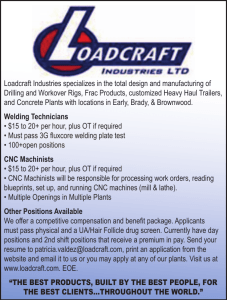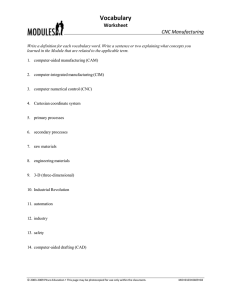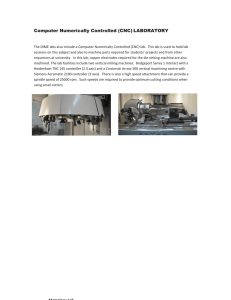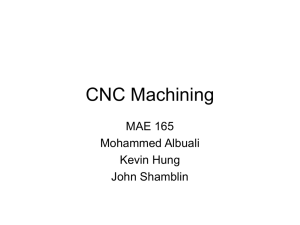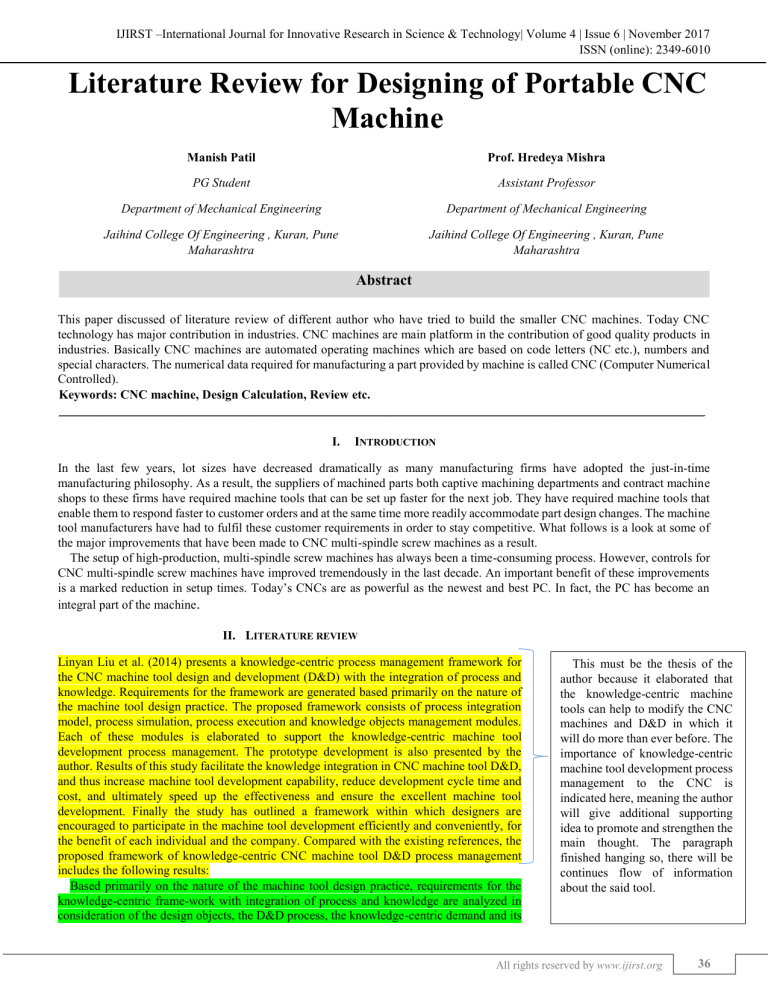
IJIRST –International Journal for Innovative Research in Science & Technology| Volume 4 | Issue 6 | November 2017
ISSN (online): 2349-6010
Literature Review for Designing of Portable CNC
Machine
Manish Patil
Prof. Hredeya Mishra
PG Student
Assistant Professor
Department of Mechanical Engineering
Department of Mechanical Engineering
Jaihind College Of Engineering , Kuran, Pune
Maharashtra
Jaihind College Of Engineering , Kuran, Pune
Maharashtra
Abstract
This paper discussed of literature review of different author who have tried to build the smaller CNC machines. Today CNC
technology has major contribution in industries. CNC machines are main platform in the contribution of good quality products in
industries. Basically CNC machines are automated operating machines which are based on code letters (NC etc.), numbers and
special characters. The numerical data required for manufacturing a part provided by machine is called CNC (Computer Numerical
Controlled).
Keywords: CNC machine, Design Calculation, Review etc.
_______________________________________________________________________________________________________
I.
INTRODUCTION
In the last few years, lot sizes have decreased dramatically as many manufacturing firms have adopted the just-in-time
manufacturing philosophy. As a result, the suppliers of machined parts both captive machining departments and contract machine
shops to these firms have required machine tools that can be set up faster for the next job. They have required machine tools that
enable them to respond faster to customer orders and at the same time more readily accommodate part design changes. The machine
tool manufacturers have had to fulfil these customer requirements in order to stay competitive. What follows is a look at some of
the major improvements that have been made to CNC multi-spindle screw machines as a result.
The setup of high-production, multi-spindle screw machines has always been a time-consuming process. However, controls for
CNC multi-spindle screw machines have improved tremendously in the last decade. An important benefit of these improvements
is a marked reduction in setup times. Today’s CNCs are as powerful as the newest and best PC. In fact, the PC has become an
integral part of the machine.
II. LITERATURE REVIEW
Linyan Liu et al. (2014) presents a knowledge-centric process management framework for
the CNC machine tool design and development (D&D) with the integration of process and
knowledge. Requirements for the framework are generated based primarily on the nature of
the machine tool design practice. The proposed framework consists of process integration
model, process simulation, process execution and knowledge objects management modules.
Each of these modules is elaborated to support the knowledge-centric machine tool
development process management. The prototype development is also presented by the
author. Results of this study facilitate the knowledge integration in CNC machine tool D&D,
and thus increase machine tool development capability, reduce development cycle time and
cost, and ultimately speed up the effectiveness and ensure the excellent machine tool
development. Finally the study has outlined a framework within which designers are
encouraged to participate in the machine tool development efficiently and conveniently, for
the benefit of each individual and the company. Compared with the existing references, the
proposed framework of knowledge-centric CNC machine tool D&D process management
includes the following results:
Based primarily on the nature of the machine tool design practice, requirements for the
knowledge-centric frame-work with integration of process and knowledge are analyzed in
consideration of the design objects, the D&D process, the knowledge-centric demand and its
This must be the thesis of the
author because it elaborated that
the knowledge-centric machine
tools can help to modify the CNC
machines and D&D in which it
will do more than ever before. The
importance of knowledge-centric
machine tool development process
management to the CNC is
indicated here, meaning the author
will give additional supporting
idea to promote and strengthen the
main thought. The paragraph
finished hanging so, there will be
continues flow of information
about the said tool.
All rights reserved by www.ijirst.org
36
Implementing and monitoring demand. Then, the framework of knowledge-centric CNC
machine tool D&D process management used in the CNC machine tool industry is proposed,
which includes the modelling, simulation and its execution and takes the knowledge into
consideration. The design process of KVC1050N Vertical machining center is also studied as
an example to demonstrate the feasibility and availability of the proposed framework. The
results of this study significantly contribute to efforts to achieve knowledge and process
integration in CNC machine tool D&D. In a word, ongoing efforts are being taken to make
the framework more practical in the industrial application. Thus, this solution can serve
machine tool companies in this important industry sector by increasing machine tool
development capabilities, improving work efficiency and ultimately reducing development
cycle time and costs. [1]
Venkata Krishna pabolu et al (2010) discuss the design and implementation of low cost
three dimensional computerized numerical control system (CNC) for industrial application.
In this paper prototyping an Embedded CNC machine was created
This section is very important
because it discuss here the
nature of machining and the
purpose of knowledge-centric to
CNC, thus this is a supporting
idea. But what could be that
example of this concept that that
the design is also responsible for
demonstrating feasibility and
availability.
Literature Review for Designing of Portable CNC Machine
(IJIRST/ Volume 4 / Issue 6 / 005)
.Detail description of different modules such as software development, Electronic/Electrical
development, along with technical details of their implementation have been given. [2]
Dr.J.B. Jayachandraiah et al (2014) provide the idea to develop the low cost Router system
which is capable of 3 axis simultaneous interpolated. The low cost is prototyping is achieved
by incorporating the features of standard PC interface with microcontroller base CNC system
in an Arduino based embedded system. With limited budget the author conclude that small
machine tools to fabricate small parts can provide flexibility and efficiency in manufacturing
approach and reduce the capital cost, which is beneficial for small business owners. [3]
Ahmed A.D.Sarhan et al. (2015) in this paper, an initial CNC gantry milling machine
structure with the potential to produce high surface finish has been designed and analyzed.
The target of the author is to achieve lowest natural frequency of 202Hz corresponding to
12000 rpm at all motion amplitudes with a full range of suitable frequency responses. Modal
analysis of the initial gantry structure design was performed and its natural frequency was
102.36HZ. To improve the dynamic behavior of the gantry structure so it can endure at
frequencies above 200HZ, a modification process was carried out to increase stiffness. The
above enhancement, appropriate behavior was attained. Deformation of less than 10 microns
ensued at the tip of the spindle when the minimum natural frequency of the gantry structure
rose slightly above 200Hz. An increase in the structure’s weight was the significant factor for
the identified deformation. However, the variation did not have a negative impact on the
precision of the machine. As a result, the weight increased after modifications to the gantry
structure were made, while the amount of deformation and overall dynamic behavior
improved. In addition, the efficacy of the Z-axis part’s position on the dynamic behavior of
the gantry structure was studied. By displacement of the spindle position, the dynamic
behavior of gantry structures will change.
Evaluations on the gantry structure’s behavior demonstrated that the least natural frequency
occurred while the Z-axis part was located below the middle of the beam. This signifies that
the structure was in a critical situation. The results shown by the author, that according to the
critical condition, the minimum frequency of the structure is acceptable. The research results
shows that the designed CNC gantry machine is capable of functioning at a speed of
12,000rpm. [4]
Nikita R. Saharkar et al. (2013) design the CAD Model in Solidworks and Done the FEA
analysis in hyper mesh tool providing the appropriate constrains, loads, and moment values.
According to the author he got the stress value around 14 Mpa which is less than the allowable
stress value of M.S. concluding the design is safe. Author also generate the G & M codes by
simulating the
CAD file in Power mill software which is nothing but the CAM software. [5]
Sundar Pandian et al. (2014) develop low cost 3 axis CNC machine using of- the- shelf
component, stepper motors with drivers, Arduino open source, microcontroller and open
source motor control software. Author used ready to assemble kit from Zen Tool works, USA.
Kit provided stepper motor, lead screw, guide rod, anti-backlash falans and spring. He made
the Body with high density PVC. The machine has fix gantry and mobile bed so there is
Is
this
part
of
Knowledge-centric
tool
machining development?
It should be clearer enough
to understand the topic. It
discuss here the budgeting
control on how to create a
prototype.
Another author discuss the
probability about modifying and
upgrading the tools. It has a
specific machine elaborated here
which is the gantry milling
machine. The objective of the
author is to pin point that lowest
natural frequency with it can
perform a dynamic behavior
This is a supporting idea for
the enhancement of frequency
that milling machines have
All rights reserved by www.ijirst.org
37
restriction in working area. Author develop Low cost CNC machine only for educational
purpose. [6]
B.Malleswara Swami et al. (2012) in this paper author describe the method for static and
dynamic analysis. Author used standard bed for analysis. The investigation is carried to
reduce the weight without changing the structural rigidity and the accuracy by adding the ribs
at the suitable location. Static analysis is done for 1g i.e. gravitational force is consider with
external load on structure and 5g i.e. gravitational force 5 times ‘g’ value is applied on
structure along with external load .In modal analysis ,the natural frequency of the body is
evaluated to find the dynamic and vibration characteristics. Then the optimize design is
generated using optistruct tool. The results which gets after optimization reduces the weight
by 1.55% with original value and average frequency shifted by appx. 8.8 % with 1st natural
frequency. [7]
Druv Patel et al. (2014) studied influences of various parameter like tool speed, tool feed
and depth of cut on CNC router and concluded from ANOVA that percentage contribution of
feed rate is maximum and it means Feed rate is the most dominating factor for modelling
surface finish. [8]
Monika Nowak et al. (2012) formulated methods of selection of geometric and physical
structure of the mobile machine by specifying the design requirements and the development
of the elimination conditions based on these requirements. The selection procedure was based
on an analysis of the functional description of the required shaping movements, carefully
developing appropriate conditions for the elimination of alternatives using the information
concerning the needs of future portable machine operators. [9]
Grzegorz szwengier et al. (2012) gives the results of research on selection on geometrickinematic structure of newly designed milling machine. There was various types of structure
combination available for milling machine, author suggested best procedure and help to select
useful combination of machine parts with desired output provided with constraints of machine.
[10]
These are just all
supporting ideas given
by the different author
that has similar studies.
This
promotes
that
knowledge-centric
machining tools is very
essential
to
every
machines
need
for
modification
and
upgrading. Technologies
and machines are the
source of different labor
that a company have,
meaning it must be
maintained and upgrade
to see if it can handle
loads of important jobs.
III. CONCLUSION
After reviewing above papers we can say that, CNC machine tools must be better designed and constructed, and must be more
accurate than conventional machine tools. It is necessary to minimize all non-cutting machine time, by fast tool changing methods,
and minimize idle motions by increasing the rapid traverse velocities to make the use of the machine tool more efficient. Digital
control techniques and computers have undoubtedly contributed to better accuracy and higher productivity. However, it should be
noted that it is the combined characteristics of the electric control as well as the mechanical design of the machine tool itself that
determine the final accuracy and productivity of the CNC machine tool system. High productivity and accuracy might be
contradictory. Because high productivity requires higher feed, speed and depth of cut, which increases the heat and cutting forces
in the system. This will lead to higher deflections, thermal deformations and vibration of the machine, which results in accuracy
Literature Review for Designing of Portable CNC Machine
(IJIRST/ Volume 4 / Issue 6 / 005)
deterioration. Therefore, to achieve high operating bandwidth while maintaining relatively high accuracy, the structure of CNC
machine tool must be more rigid and stiff than its conventional counterpart.
To achieve better stiffness and rigidity of structure, several factors should be considered in the design. The first concern is the
material. Conventional machine tools are made of cast iron. However, the structures of CNC machines are usually all-steel-welded,
constructed to achieve greater strength and rigidity for a given weight. In addition, better accuracy is obtained in CNC machines
by using low-friction moving parts, avoiding lost motions and isolating thermal sources. Regular sliding guides have higher static
friction than the sliding friction. The force used to overcome the static friction grows too large when the guide starts to move. Due
to inertia of the slide the position goes beyond the controlled position, adding overshoot and phase lag to the system response, and
affects the accuracy and surface finish of the part. This can be avoided by using slides and ball screws in which the static friction
is lower than the sliding friction for example, rolling type parts such as ball-bearing ball screw and recirculating linear slides can
be used.
REFERENCES
[1]
[2]
[3]
“A knowledge-centric Machine Tool Design & Development Process Management Framework”, International Journal of Production Research, 2014, vol.
52, no20, 6033-6051, by Linyan liu, Barrets s.calwell, Huifen wang, Ying li
“Design and Implementation of Three dimensional CNC machine”, International Journal of Computer Science and Engineering, Nov.2010, vol 02,
25672570, by Venkata krishna pabalu, Prof.k.n.h.shrinivas
“Fabrication of Low cost 3 axis CNC Router”, International Journal of Engineering Science Invention, ISSN (online):2319-6734, ISSN (print) 2319-6726,
vol 3 issue6, june2014, by Dr.J.B. Jayachandraiah, o vamsikrishna, P.abdullah khan,R.ananda Reddy
All rights reserved by www.ijirst.org
38
“Improvement on CNC Gantry Machine Structure Design for Higher Machining Speed Capability”, International Journal of Mechanical, Aerospace,
Industrial and Mechatronics Engineering, vol 9, Nov: 2015,by Ahmed a.d.sarhan, S.r.besharaty, Javed akbaria, m.hamdi
[5] “Prototype Development of Milling Machine Using CAD/CAM”, International Journal of Science And Research, ISSN 2319:7064, vol.4 issue 8 2015, by
Nikita r saharkar ,Girish m dhote
[6] “ Low cost build your own three axis CNC mill prototype”, International Journal of Mechanical Engineering and Robotics, ISSN 2321-5747,vol,2
issue1,2014 by Sundar Pandian ,Raj Pandian.
[7] “Design Optimization of CNC Vertical Milling Machine Bed”, Indian Streams Research Journal, vol.2, issue 7, 2012 by B.Malleswara swami, K. Sunil
ratna kumar, C.H Ramakrishna
[8] “An Investigation Effect of Machining Parameters on CNC Router”, IJEDR, ISSN: 2321-9939, vol. 2, issue 2 ,2014, by Mr.Dhruv H. Patel, Prof. V. N.
Patni
[9] “Selection of Kinematic Structure for Portable Machine Tool”, Advances In Manufacturing Science and Technology, vol.36, no.1, 2012 by Monika Nowak,
Daniel Jastrzębski
[10] “Selection of Milling Machine Kinematic Structure Preliminary Selection of Structure Variants ”, Archives of Mechanical Technology and Automation,
vol.32, no.1, 2012 65-75,by Grzegorz Szwengier
[4]
All rights reserved by www.ijirst.org
39

